Physical Address
304 North Cardinal St.
Dorchester Center, MA 02124
The term cerebrovascular disease refers to a group of conditions in which the brain or spinal cord is injured by a vascular cause. The onset is generally abrupt, but it also can be insidious. Clinical manifestations depend on the location and extent of damage to neural structures. Although risk factors and treatments may overlap, cerebrovascular diseases are pathophysiologically divided into those in which an insufficiency in the blood supply causes ischemic injury and those in which bleeding, either into the parenchyma (intracerebral or much more rarely intraspinal hemorrhage) or into the space between the pial and arachnoid coverings over the brain or spinal cord (subarachnoid hemorrhage), causes direct neural injury, leads to secondary ischemic injury, or acts as a space-occupying lesion. Cerebrovascular disease is often both preventable and treatable.
Nearly 800,000 Americans have a stroke each year, and about 77% are first strokes. Stroke is the underlying cause of death of about 150,000 Americans each year, corresponding to approximately 1 in 19 deaths in the country.
Stroke causes about 6.55 million deaths and about 143 million disability-adjusted life-years lost worldwide. Before the severe acute respiratory syndrome coronavirus 2 (SARS-CoV-2) pandemic, stroke was the second most common cause of death worldwide, after ischemic heart disease, and the third leading cause of disability-adjusted life-years lost behind neonatal disorders and heart disease. In 2020, stroke was the fifth leading cause of death in the United States (behind diseases of the heart, cancer, coronavirus disease 2019 (COVID-19), and unintentional injuries/accidents).
Globally, age-adjusted stroke mortality decreased by 14% between 2007 and 2017, but the annual decrease gradually slowed over that time. In the United States, age-adjusted stroke-related mortality decreased by 6.6% between 2009 and 2019, but the total number of stroke deaths increased by 16%.
The overall prevalence of stroke is estimated at 2.7%, with 7.6 million Americans age 20 years or older having had a stroke. Even when the incidence of stroke was declining, largely because of better prevention, a declining case-fatality rate (from a 30-day rate of about 20% in 2003 to about 13% in 2017) in the United States and other developed countries has kept the population prevalence relatively stable.
The risk for stroke generally increases with age, and it doubles for every decade after the age of 55 years. Symptoms consistent with transient focal cerebral ischemia (a transient ischemic attack [TIA]) in which there is no evidence of permanent tissue injury, have a 9 to 17% risk of stroke by 90 days. A retinal vein occlusion increases the risk of stroke in the next 30 days by about 2.6-fold. In patients with asymptomatic stenosis of an extracranial carotid artery, the risk of ipsilateral stroke increases as the stenosis increases in the range between 50% and 99%.
About 60% of stroke deaths occur in women, but the rates are actually highest in Black men. It is estimated that someone in the United States has a stroke about once every 40 seconds. In addition, Blacks, people with lower levels of education, individuals who reside in the southeastern portion of the country (the “Stroke Belt”), and individuals with a first-degree relative who had a stroke before the age of 65 years have a higher risk for stroke and stroke-related mortality. Poor diet, lack of exercise ( Chapter 14 ), cigarette smoking ( Chapter 363 ), exposure to environmental tobacco smoke, obesity ( Chapter 201 ), and excess alcohol consumption ( Chapter 364 ) are lifestyle factors that greatly increase the risk for stroke. Of the medical conditions that increase the risk for stroke, hypertension ( Chapter 64 ) has the highest population-attributable risk. Other stroke risk factors include atrial fibrillation ( Chapter 52 ), diabetes ( Chapter 210 ), dyslipidemia ( Chapter 190 ), inflammatory states, elevated homocysteine levels, high lipoprotein (a), carotid artery stenosis, patent foramen ovale ( Chapter 55 ), other congenital heart defects, sleep apnea ( Chapter 374 ), and chronic kidney disease. Coagulation disorders ( Chapter 67 ), oral contraceptive agents ( Chapter 220 ), and migraine headache with aura ( Chapter 367 ) also may contribute to the risk. For many of these risk factors, primary or secondary prevention can substantially reduce the risk of a first or recurrent stroke. ,
Mendelian diseases associated with stroke include sickle cell disease ( Chapter 149 ); mitochondrial encephalopathy, lactic acidosis, and stroke (MELAS); cerebral autosomal dominant arteriopathy with subcortical infarcts and leukoencephalopathy (CADASIL; Chapter 371 ); Fabry disease ( Chapters 192 and 254 ); and Marfan syndrome ( Chapter 239 ). In addition, autosomal dominant polycystic kidney disease ( Chapter 112 ) is associated with intracranial aneurysms and fibromuscular dysplasia. Ehlers-Danlos type IV ( Chapter 239 ) is also associated with intracranial aneurysms as well as cervical arterial dissection. Several genetic polymorphisms also have been associated with stroke, but these genetic markers are not yet clinically relevant.
An understanding of vascular anatomy and its normal variants as well as their relationships to functional neuroanatomy can provide important clues for identifying the cause of cerebrovascular symptoms and signs in individual patients and can also help guide treatment.
Paired carotid and vertebral arteries normally supply the brain ( Fig. 375-1 ). The right common carotid artery arises from the brachiocephalic trunk (innominate artery), which then gives rise to the right subclavian artery. The right vertebral artery generally arises from the proximal portion of the right subclavian artery. The left common carotid artery usually arises directly from the aortic arch; but in some individuals, it may arise from the proximal portion of the brachiocephalic trunk (“bovine” anatomy). The left subclavian artery originates from the aortic arch distal to the left common carotid artery and also supplies the left vertebral artery.
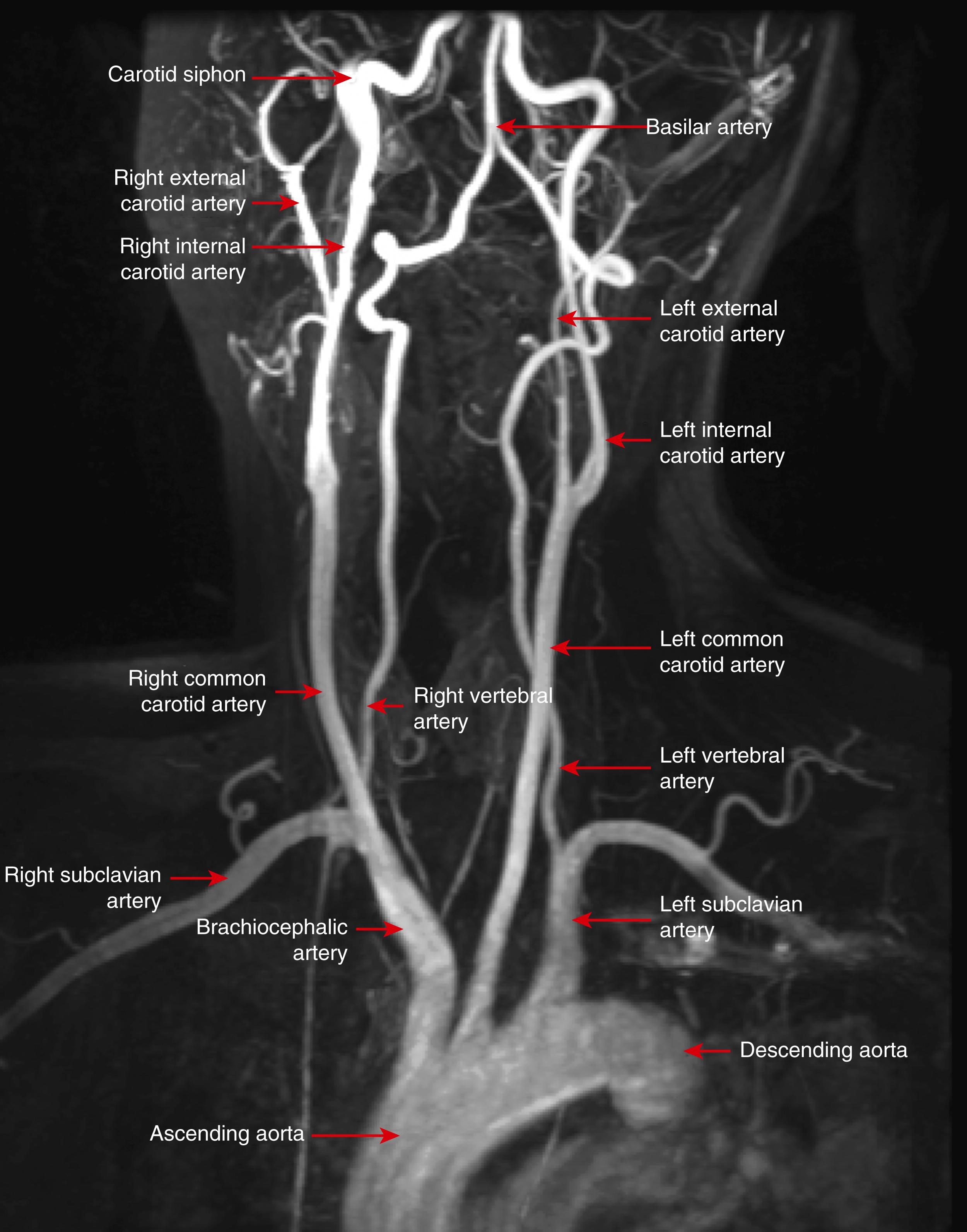
The common carotid arteries bifurcate into the internal carotid artery and external carotid artery in the neck, generally at the level of the thyroid cartilage. The bifurcation may less commonly occur above the lower level of the mandible or lower in the neck. The internal carotid artery enters the skull through the foramen lacerum and travels through the petrous bone adjacent to the inner ear. It then enters the cavernous sinus, ascends in an S shape (carotid siphon), penetrates the dura, and finally divides into the anterior cerebral artery and middle cerebral artery ( Fig. 375-2 ). The ophthalmic artery can originate from the internal carotid artery in the carotid siphon, but it more commonly arises from the supraclinoid internal carotid artery, followed by the posterior communicating and anterior choroidal arteries.
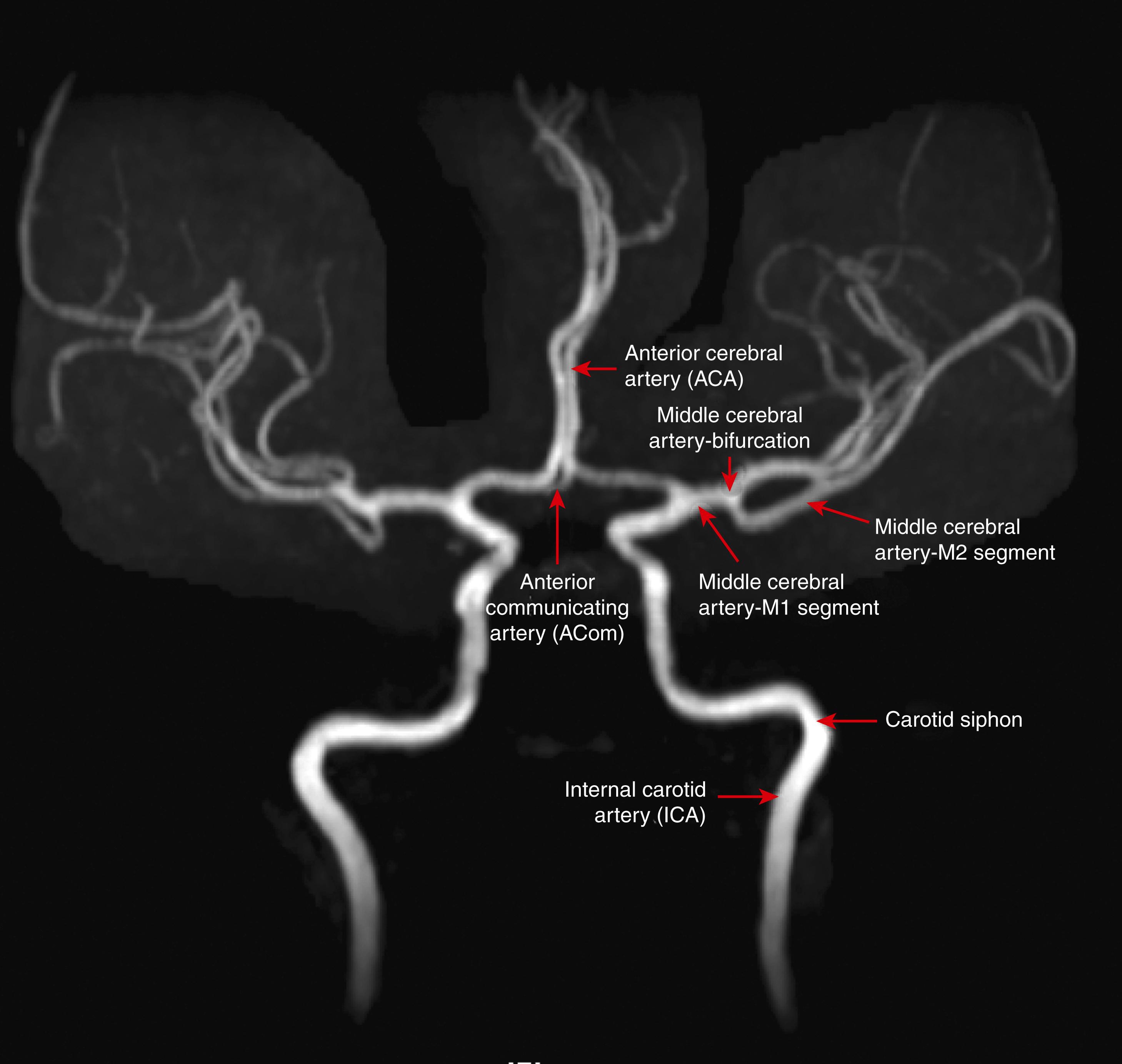
The external carotid arteries have extracranial branches, thereby distinguishing them from the internal carotid arteries. The superficial temporal arteries (palpable anterior to the ears) and facial arteries can anastomose with the intracranial circulation through branches of the ophthalmic artery and can be clinically important, potentially supplying the intracranial circulation in the setting of a proximal internal carotid artery occlusion.
Although the vertebral arteries generally arise from the subclavian arteries, they can also originate from the aortic arch or thyrocervical trunk. They most commonly enter the C6 transverse process but may also enter at the C4, C5, or C7 levels. They exit the transverse processes at C1, turn posteriorly behind the atlantoaxial joint, and then pass through the dura at the foramen magnum. Intracranially, they typically join at the pontomedullary junction to form the single basilar artery, although the vertebral artery can end in the posterior inferior cerebellar artery in some individuals ( Fig. 375-3 ). The portion of the vertebral artery between its origin and its entry into the transverse process is referred to as the V1 segment. The V2 segment refers to the portion of the artery traveling through the transverse foramina; the V3 segment, the portion between where the artery exits the transverse foramina and penetrates the dura; and the V4 segment, the intracranial portion of the artery. One vertebral artery may be hypoplastic ( E-Fig. 375-1 ). Clues are that the ipsilateral transverse foramina are generally smaller on the side of the hypoplastic artery and that the proximal portion of the basilar artery can be displaced ipsilateral to the hypoplastic artery. The V3 segment is particularly vulnerable to mechanical injury that can lead to dissection. The vertebral arteries have medial branches that unite to form the anterior spinal artery and lateral branches that supply the dorsolateral medulla and inferior portion of the cerebellum, which also supplies the vestibular nuclei ( Fig. 375-4 ). Other medial branches of the vertebral artery supply the medullary pyramid, inferior olivary nucleus, medial lemniscus, and hypoglossal nerve fibers. Longer circumferential branches from the vertebral arteries and posterior cerebral arteries supply the spinothalamic tracts and sympathetic fibers as they traverse the medulla, the sensory nuclei, and the descending tracts from cranial nerve V as well as emerging fibers from the vagus and glossopharyngeal nerves.
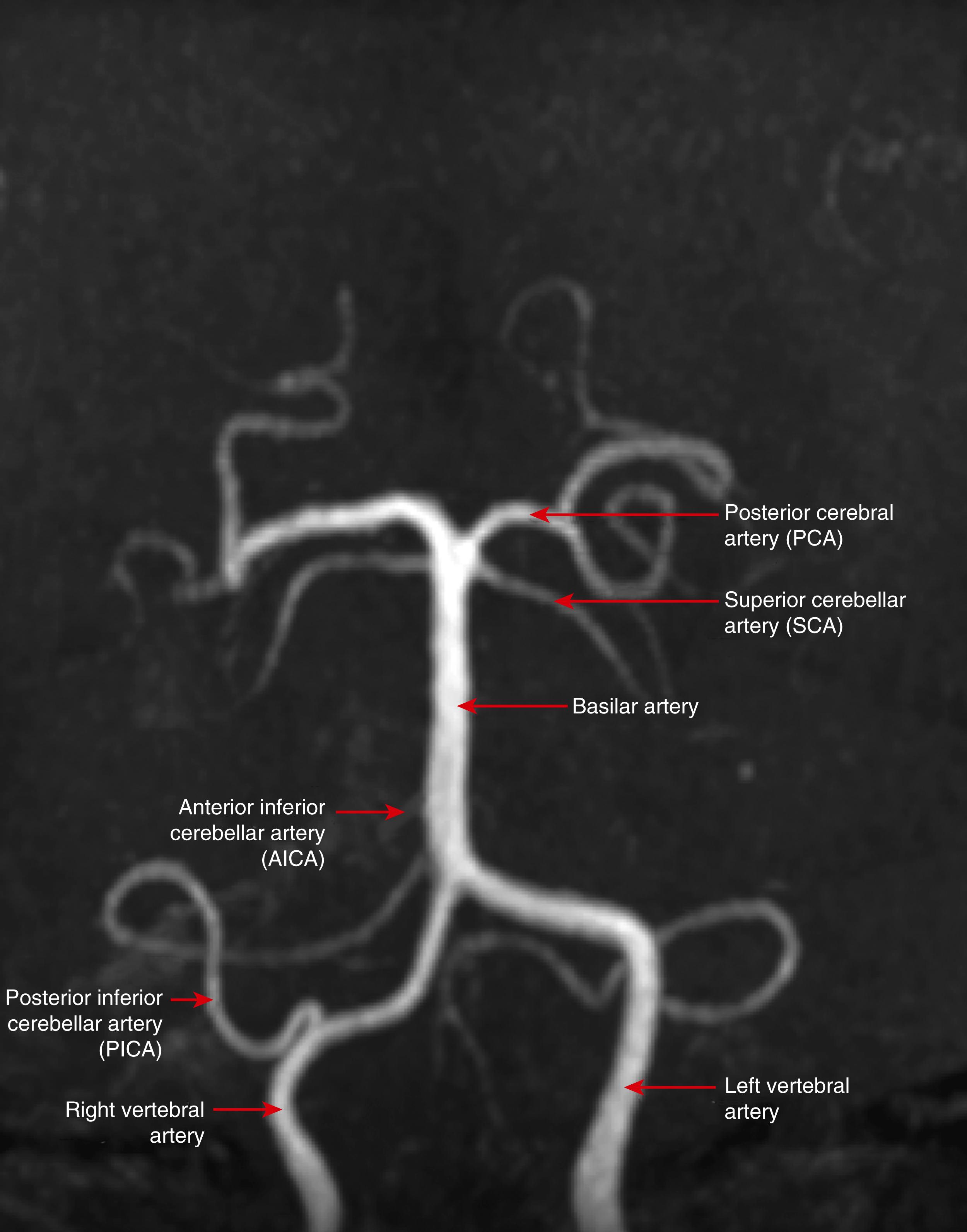
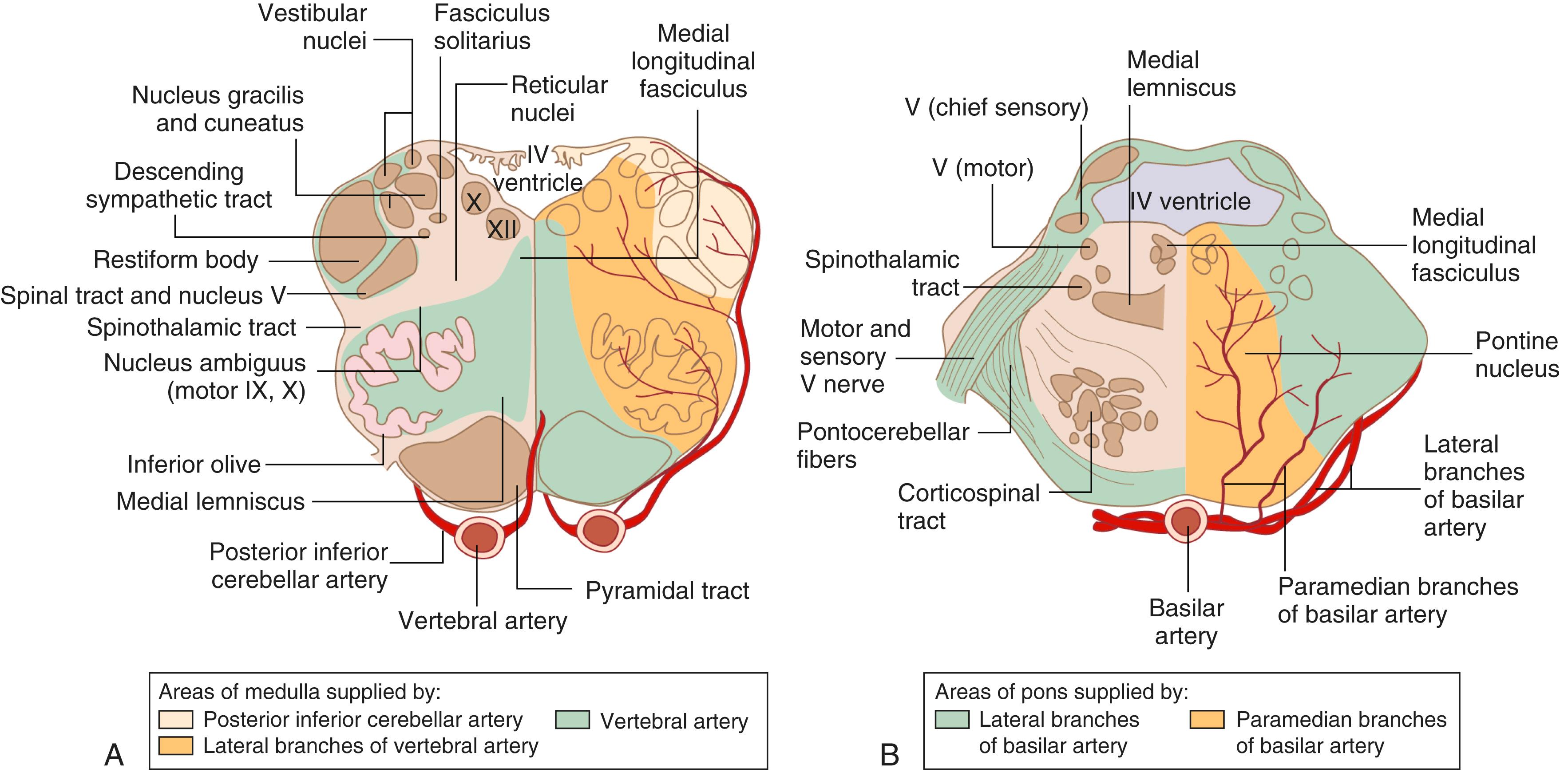
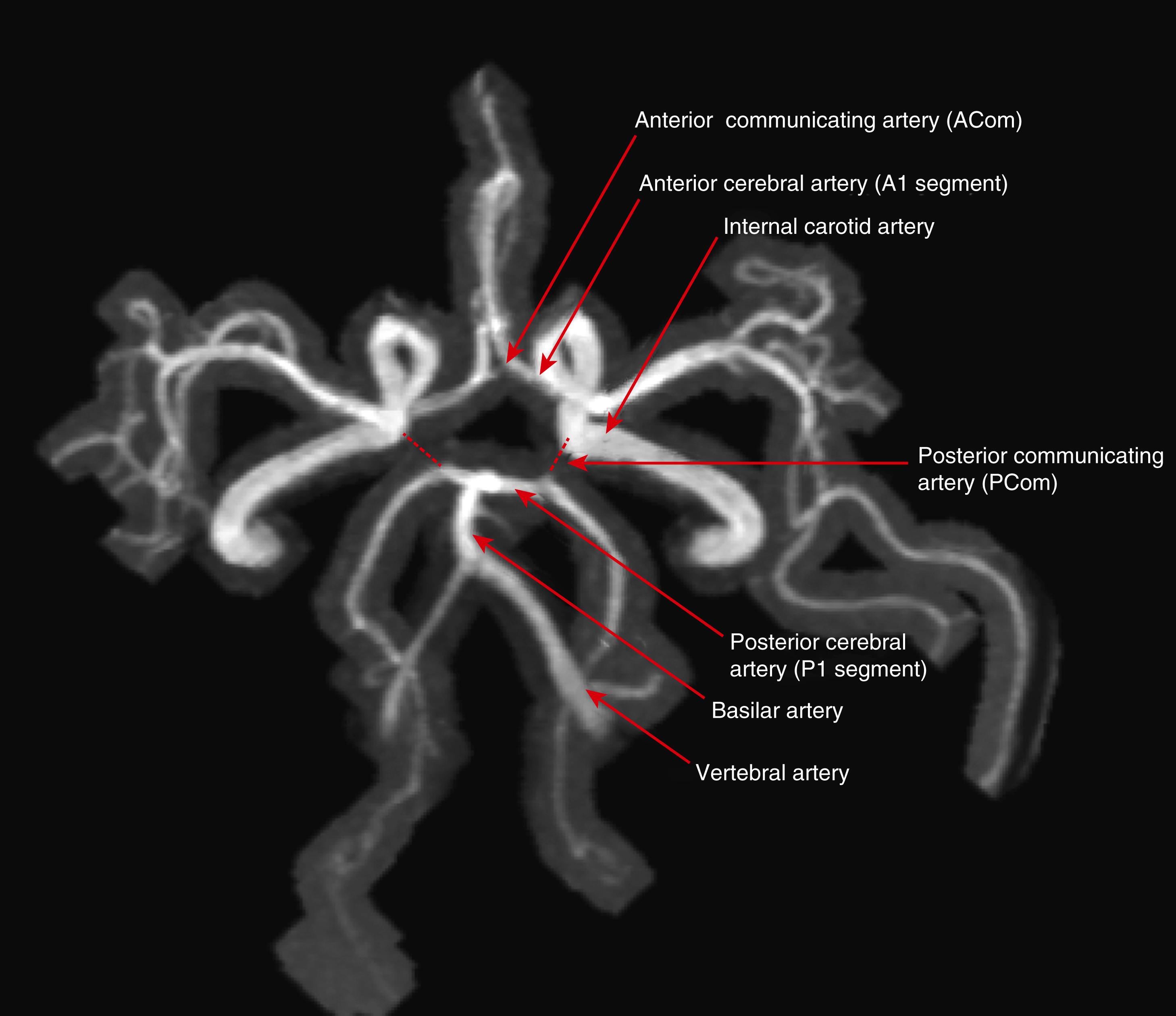
The basilar artery has small penetrating branches supplying the dorsal portions of the pons and midbrain (see Figs. 375-3 and 375-4 ). The anterior inferior cerebellar arteries originate from the mid-basilar artery. They supply portions of the cerebellar hemispheres in addition to the lateral pons; cranial nerves V, VII, and VIII; and pontine portions of the spinothalamic tracts and sympathetic fibers. The two superior cerebellar arteries arise from the distal basilar artery at the level of the midbrain proximal to the common origin of the two posterior cerebral arteries. The oculomotor nerves exit the midbrain between the superior cerebellar artery and posterior cerebral artery. The superior cerebellar arteries give branches supplying the dorsal midbrain, including the colliculi and the superior portions of the cerebellar hemispheres and vermis. The long circumferential vessels also supply the dorsolateral brain stem.
In addition to the anterior inferior cerebellar artery and superior cerebellar artery, the basilar artery has paramedian vessels supplying the middle portion of the basis pontis and midline pontine structures, including the corticospinal tracts, medial longitudinal fasciculus, and pontine reticular nuclei. At the midbrain level, paramedian branches of the basilar artery supply the cerebral peduncles, cranial nerve III nuclei and fibers, and medial portions of the red nucleus and medial lemniscus. Short circumferential branches supply the ventrolateral pons and midbrain.
Become a Clinical Tree membership for Full access and enjoy Unlimited articles
If you are a member. Log in here